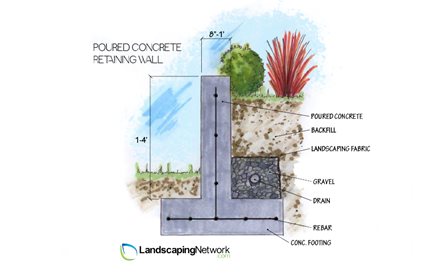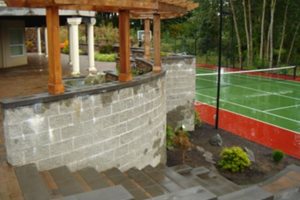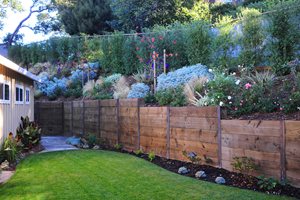Poured Concrete Retaining Walls
Why concrete walls are a good option for mild climates and modern homes
Many contractors shy away from poured concrete, preferring to use CMU block with a plastered face. The risk of cracking in poured walls and the difficulty in repairing them makes block and plaster a more forgiving choice. This simple retaining wall utilizes a beautiful travertine stone cap upgrade.
Perhaps the finest examples of poured concrete walls can be seen every day along freeways where these structures are constructed on a massive scale. Watch any of these in process and you get a real appreciation for the skill required to form and pour a perfect wall. There are so many things that can go wrong in this process that it's a difficult solution for residential landscape retaining walls.
- Pro Tip: With poured concrete, you have to form in the negative, which can be a visual challenge. Block walls are built the positive all the time. If there's a problem, we'll see it right away. --Joseph Heuttl, Huettl Landscape Architecture in Walnut Creek, CA
Concrete Retaining Wall

Concrete Retaining Wall (PDF)
Poured concrete walls can be tricky to install, but look great with the architectural elements of a modern house.
Challenges for Concrete Retaining Walls
Most landscape contractors in areas of heavy rainfall or weather extremes avoid fine poured concrete work due to its challenges. Woody of Woody's Custom Landscaping in rainy Vancouver, Washington does not recommend them for his projects. "When a concrete wall fails, it's over. You have to build a new wall from scratch. Cracks are a huge problem - sure you can patch them but it's hard to do. We consider the entire wall a loss because there's no long term fix." They are growing however in scattered mild climate enclaves such as southern California where modern design has brought a new wave of interest in this type of retaining wall.
Woody also stresses the importance of skilled concrete contractors. "The forms have to be immaculate. Otherwise you risk a wave or bulge in the wall. Where strict geometric forms are required, this kind of variation can be disastrous. Plus, the concrete itself has to be tamped perfectly if the wall is to bear a smooth surface. That's hard to do with retaining walls because there is so much steel inside - it's a whole lot of rebar tied into enormous footings."
Poured Concrete vs. CMUs
This unforgiving nature of poured concrete explains why they are not often seen in residential landscapes. The evolution of more reliable retaining wall systems and the use of a CMU core allows the landscaper to achieve a great look without the cost or risk. However, some landscape architects and their clients who extend poured concrete architectural elements of a modern house must bring this material into their exterior walls and retaining walls.
Landscape Architect Joseph Huettl of Walnut Creek, California uses both of these methods. "There's no question, an 8" concrete wall is stronger than an 8" block wall. You can use admixtures to help adjust to climatic issues for greater control of moisture intrusion. For walls under four feet, we use a Simpson tie system that our crews have mastered to allow us to pour walls quickly with high degree of success. The downside is that it takes a long time to build the forms, but once they're up and the pour is complete, there's nothing more to do. Plus, you don't see the error until you pull the forms."

This beautiful small home entry combines plaster with travertine paving and wall caps. This demonstrates how elegant simple solutions can be that may prove more sustainable over time. A block wall with a plaster face can be easily repaired or replastered should there be any discoloration or water seepage from planters at the top. Planters in direct contact with retaining walls can be a risky choice due to the danger of water seepage through the wall to compromise its structural core and discolor the face.
The majority of landscapers today can achieve a similar look with a block CMU core plastered to resemble poured concrete. "We use block with a hard trowel plaster that looks identical to poured concrete. We also like to use smooth stucco that also looks just as good. But we've had some difficulty with cracking of these coatings on block walls at the mortar joints underneath if the masonry isn't top notch."
Footings & Reinforcement for Concrete Retaining Walls
If poured concrete is to be used, it should be designed by a landscape architect to ensure there is adequate footings and steel. For example, if waterproofing fails and moisture causes the face of the wall to discolor, however slightly, the plaster may be stripped, the seepage repaired and the wall recovered to look like new. Comparatively, such a problem with poured concrete is disastrous. Poured concrete walls also offer the opportunity to create a board-formed finish look. Read more about how to achieve board-formed concrete. It's also possible to achieve very organic and creative finishes such as this unique vertical concrete wall.
The footing will extend outwards from the face of the wall or out the back depending on the type specified by architect or engineer. This does have some influence on the adjacent planting at the base of the face of the wall. Overly large footings that extend considerable distance out from the wall can create drainage problems for lawns. It also prevents excavation of planting holes of shrubs and trees. For this reason, your designer will coordinate the footing size and dimensions with paving or planting that runs along the face of the retaining wall to accommodate any limitations.

 Backyards
Backyards
 Front Yards
Front Yards





